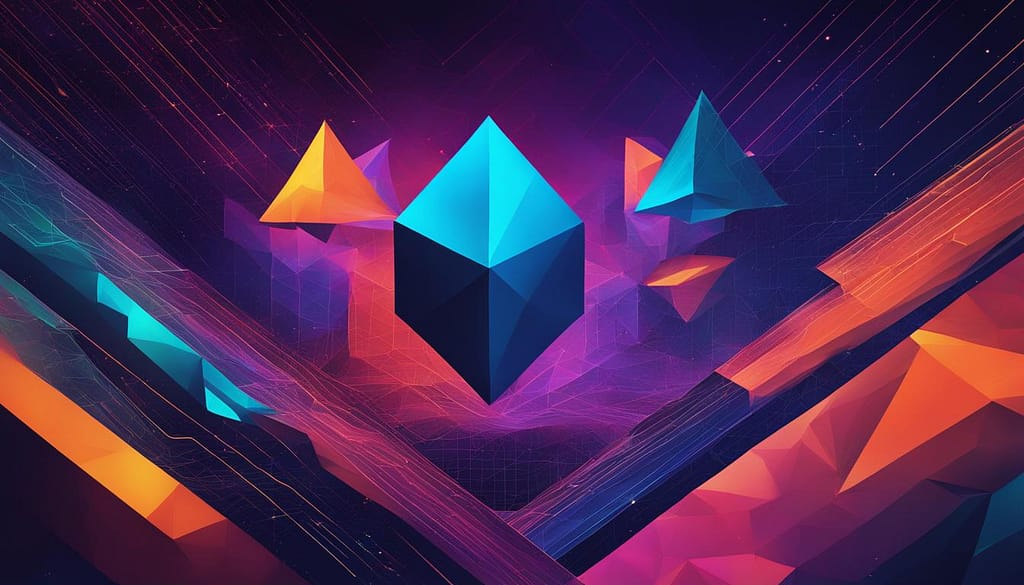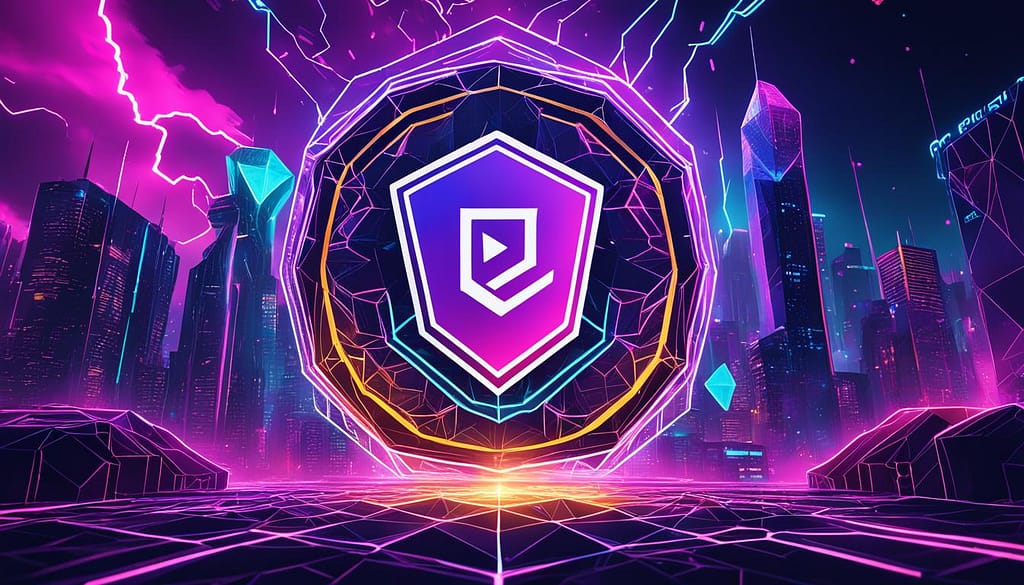What is Polygon Coin?
As the digital era progresses, cryptocurrencies continue to pave their innovative pathways within the financial landscape. Among them, Polygon has emerged as a notable digital asset and a technologically advanced blockchain network. Bridging gaps in the burgeoning world of cryptocurrencies, Polygon is ingeniously designed as Ethereum’s internet of blockchains, offering a transformative solution to the critical challenge of scalability. In a digital ecosystem where transaction speed and flexibility are paramount, this native token, symbolized by MATIC, stands as a pillar of connective efficiency and a beacon of blockchain empowerment.
Polygon’s ingenious architecture capitalizes on enhancing Ethereum-based projects. By fortifying their operational and developmental aspects, it remains steadfast in its commitment to providing a modular framework that is synonymous with adaptability and sovereignty. The digital asset’s core utility within the platform encompasses governance, security, and fee payment, ensuring a seamless experience for its vast user base. Let’s delve into the multifaceted sphere of Polygon and unravel what makes it a critical component of the crypto universe.
Key Takeaways
- Polygon is renowned for amplifying Ethereum’s capabilities, addressing scalability and bridging various blockchain networks.
- The cryptocurrency’s associated digital asset, MATIC, serves multiple roles within the network, including governance and fee processing.
- A refined proof-of-stake mechanism underpins the platform’s promise of efficiency and rapid transaction processing.
- The integration with Ethereum is a testament to Polygon’s scalability focus, ensuring a harmonious expansion of the Web 3.0 paradigm.
- As a Layer 2 scaling solution, it sets the stage for unprecedented performance enhancements across decentralized applications.
- Securing a strategic place in the ever-evolving blockchain landscape, Polygon continues to create robust solutions for network limitations.
The Origins and Evolution of Polygon (MATIC)
The inception of Polygon, initially known as the Matic Network, marked a significant leap forward for blockchain networks. Conceived in 2017, its core objective was to forge a suite of Ethereum-compatible projects, fostering an environment where scalability and interoperability are not just ideals, but everyday realities. The metamorphosis from Matic to Polygon network was more than a mere rebrand; it represented a broader vision for facilitating a seamless and interconnected blockchain infrastructure.
Genesis: From Matic Network to Polygon
As a pioneering venture, the Matic Network served as an early beacon, guiding the sphere of Ethereum-based advancements onto a path of enhanced performance and flexibility. By addressing critical pain points such as transaction speeds and gas fees, the network quickly ascended as a harbinger of the next generation of blockchain networks.
The Polygon Mandate: Ethereum’s Internet of Blockchains
Within the digital canvass of decentralized networks, Polygon emerged as a resolute force striving to create Ethereum’s very own internet of blockchains. Aiming high, it sought not just to enhance existing infrastructure but to establish a fully-fledged multichain system. This audacious goal was vital for developers and users alike, as it promised a new era of accessibility and fluid communication among blockchain networks.
Founding Team and Vision
Jaynti Kanani, Sandeep Nailwal, Anurag Arjun, and Mihailo Bjelic were not just founders; they were visionaries who perceived the immense potential of a unified blockchain structure. The exemplary leadership and unparalleled ambition of these individuals have seen Polygon transition from a project to a platform that now underpins over 7,000 blockchain initiatives. Their unwavering commitment has been instrumental in spearheading a movement towards a decentralized internet—a testament to their foresight in establishing a foundation poised to embrace the widespread adoption of Web 3.0.
How Polygon Integrates with Ethereum Blockchain
Polygon’s architecture provides a Layer 2 solution that enhances the Ethereum blockchain by focusing on critical aspects such as transaction speed, modularity, and developer experience. By positioning itself as a partner to Ethereum, Polygon creates a symbiotic relationship where it leverages the existing security and network effects of Ethereum, while offering an advanced platform with its own blockchain sovereignty. This allows developers to build and scale decentralized applications (dApps) more efficiently.
The strategic integration embraces Ethereum’s shift to a proof-of-stake consensus mechanism, bringing the added advantage of speed and efficiency to the table. Polygon’s own customized proof-of-stake variant further streamlines transaction processing, representing a valuable counterpart to Ethereum’s infrastructure. This relationship is defined by a multi-faceted approach:
- Addressing Ethereum’s congestion issues and high gas fees without compromising on decentralization.
- Empowering developers with a friendly and accommodating ecosystem that fosters innovation and growth.
- Ensuring that upgrades and applications are fully compatible with Ethereum’s environment, avoiding fragmentation.
Polygon’s drive towards modularity implies that developers have the flexibility to tailor their projects by choosing the appropriate scaling solutions that best fit their needs. Below is a comparison of essential features provided by both Ethereum and Polygon in their combined ecosystem:
| Feature | Ethereum | Polygon |
|---|---|---|
| Transaction Throughput | Limited by block size | Enhanced by Polygon’s Layer 2 mechanisms |
| Developer Tools | Robust ecosystem | Extensions for scalability and customization |
| Consensus Mechanism | Proof-of-Stake | Optimized Proof-of-Stake |
| Network Fees | Can be high during congestion | Significantly reduced |
In summation, Polygon’s Layer 2 solutions carry the vision of a more accessible blockchain functionality forward. They don’t compromise on the sovereignty of individual blockchains, provide a haven for developers through an enhanced experience, and uphold a reputation for speed and modularity. As Ethereum continues to evolve, Polygon stands as a critical alley in the narrative of blockchain scalability and application development.
MATIC: The Utility Token of Polygon
The MATIC token is the lifeblood of the Polygon network, serving multiple crucial roles that uphold the ecosystem’s vast functionalities. As an ERC-20 token, it exemplifies the standard for creating interoperable tokens over the Ethereum blockchain, assuring seamless transactions within the expansive Ethereum universe. MATIC’s integration within the network goes far beyond just a medium of exchange, solidifying its position as a pivotal asset within the cryptocurrency sphere.
Understanding ERC-20 Tokens
ERC-20 tokens exist as smart contracts on the Ethereum blockchain and are used extensively in decentralized applications (dApps). The versatility of ERC-20 tokens like MATIC contributes significantly to their prominence in digital transactions and token governance systems.
Utility Functions: Governance and Transaction Fees
MATIC takes centre stage in governing the Polygon network, where token holders wield decision-making power over proposals that guide the platform’s future. Moreover, they play a critical role in the facilitation of network transaction fees, ensuring fast and seamless transactions across the network. The undeniable advantage of MATIC’s utility includes driving community involvement and network security through staking incentives and fee settlements.
Proof-of-Stake and MATIC
Polygon’s adoption of the proof-of-stake consensus mechanism has elevated the MATIC token beyond its utility status into a stakeholder’s tool for securing the network. By participating in network validation, MATIC token holders not only contribute to the platform’s robustness but also enjoy rewards that encourage active engagement in the network’s wellbeing. The integration of proof-of-stake consensus aids in maintaining outstanding efficiency and plays a fundamental part in ensuring network transaction fees remain competitively low.
| Block Processing Time | Network Transaction Fee | Consensus Mechanism |
|---|---|---|
| 2.1 seconds | Consistently low | Proof-of-Stake |
| *Data reflects Polygon network’s average processing metrics | ||
With its swift processing and cost-effective transaction fees bolstered by the proof-of-stake model, the MATIC token showcases a blend of functionality and accessibility that represents the essence of blockchain evolution.
Layer-2 Scaling Solutions: Polygon’s Proof of Stake Mechanism
The modern landscape of blockchain technology often grapples with scalability issues, high transaction fees, and slow transaction processing times, especially when it comes to Ethereum. However, Polygon’s Layer-2 scaling solutions present an efficient and cost-effective avenue through its distinctive consensus mechanism and optimized transaction validation procedures.
Polygon’s proof of stake architecture shines as a beacon for projects entangled in Ethereum’s web of scalability constraints. By enabling transactions to achieve consensus with single block confirmations, Polygon aligns itself as a platform adept at tackling the notorious high fees and sluggish transaction speeds associated with Ethereum’s network.
- Reduces network congestion and associated costs
- Amplifies transaction throughput significantly
- Facilitates a more seamless user experience
The strategic implementation of Polygon’s Layer-2 solution atop the Ethereum blockchain not only cushions against the scalability challenges but also provides invaluable benefits, including:
Enhanced scalability, expedited processing times, and lowered cost structures enable accelerated innovation and growth within the blockchain space.
As a result, projects can scale effectively without compromising on speed or cost-efficiency, addressing two central pain points that have plagued Ethereum-based applications historically.
By solving the trilemma of decentralization, security, and scalability, Polygon emerges as a tactical Layer-2 solution, diminishing the limitations once considered inherent to blockchain architectures and supporting a new era of crypto-applications, all the while ensuring that the backbone of blockchain—security and decentralization—is kept intact.
Strengthening Ethereum: Polygon’s Approach to Scalability
The quest for advancing the Ethereum blockchain towards unparalleled efficiency has been met with innovative solutions by Polygon, particularly in the domains of network scalability and transaction throughput. As Ethereum evolves with its Ethereum 2.0 upgrade, Polygon persists in playing a pivotal role in enhancing the network’s capability to meet modern demand.
Sidechains and Layer-2 Scaling
Polygon’s integration of sidechains operates as a foundational element in its scalability solutions. These sidechains run in parallel to the main Ethereum chain, carrying out complex computations and transaction processing, while the main chain secures the network. This Layer-2 scaling actively reduces congestion on the Ethereum blockchain, significantly increasing transaction throughput without compromising the network’s inherent security.
By offloading transactions from the Ethereum mainnet to sidechains, Polygon achieves a substantial uptick in transactions per second. With such a system, Polygon turns into a high-speed network superhighway alongside the Ethereum blockchain, providing a clear pathway to scale decentralized applications in response to user demands.
Transaction Throughput and Efficiency
Efficiency isn’t just about speed; it’s about doing more with less. Polygon’s architecture enhances transaction throughput to such an extent that, compared to Ethereum’s original capability, it’s like comparing a sprinter to a marathon runner both delivering their best at their own paces. Here’s a comparison illustrating the dramatic improvement:
| Ethereum Pre-Upgrade (TPS) | Polygon Sidechain (TPS) |
|---|---|
| 14 | 7,000 |
| Transaction Fees | Efficiency Gain |
| Higher due to network load | Significantly lower, enabling micro-transactions |
This surge in transaction throughput places Polygon at the forefront of enabling fluid, affordable transactions for users and developers, thus redefining the scope of what’s possible on the Ethereum blockchain.
Ethereum 2.0 and Polygon’s Complementary Role
As the Ethereum blockchain embarks on its highly anticipated transformation to Ethereum 2.0, some may question the relevance of sidechain technologies. However, Polygon’s role does not diminish; rather, it complements Ethereum 2.0’s goals by providing a multi-pronged approach to scalability. Essentially, as the Ethereum mainnet grows stronger, Polygon’s sidechains optimize the expanded capabilities, ensuring that scalability never becomes an afterthought in the continuously evolving blockchain ecosystem.
“While Ethereum 2.0 seeks to address core scalability through its proof-of-stake consensus, Polygon’s sidechains work in tandem, providing developers and users with an adaptable and scalable environment that leverages the strength of Ethereum’s new backbone.”
Key Features and Advantages of Polygon
The emergence of blockchain technology and the need for fast transaction processing and low transaction fees have set the stage for the rise of platforms like Polygon. Offering a myriad of pivotal benefits to the cryptocurrency ecosystem, Polygon provides an efficient and economical experience for users. Its support for a wide range of decentralized applications (dApps) powers an ever-expanding digital realm, free from intermediaries and centralized control.
While leveraging Ethereum’s robust blockchain foundation, Polygon extends the value offering with unique capabilities, particularly in terms of interoperability among diverse blockchains. This interoperability is not merely a testament to technological innovation but also reflects a forward-thinking approach to making blockchain platforms more accessible and practical for mainstream adoption.
In light of its numerous advantages, let us delve into the core features that make Polygon stand out:
- Scalability: By solving crucial scalability challenges, Polygon ensures that dApps can accommodate growing user bases without compromising on speed or increasing transaction costs.
- Sovereignty: Unlike other Layer 2 solutions, Polygon enables blockchains to retain their autonomy while still benefiting from the security and connectivity of the Ethereum network.
- User and Developer Experience: By simplifying the transaction process and reducing associated fees, Polygon offers a seamless experience for users and developers alike.
Moreover, here is a comparative analysis of Polygon’s features against traditional blockchain metrics:
| Feature | Polygon | Conventional Blockchains |
|---|---|---|
| Transaction Speed | Significantly faster | Comparatively slower |
| Transaction Cost | Minimal fees | Higher fees |
| Network Interoperability | Highly interoperable | Limited to none |
| dApp Support | Extensive | Varies significantly |
Nevertheless, despite its strengths, it is essential for stakeholders to comprehend that as a Layer 2 solution depending on Ethereum, Polygon is susceptible to overarching network challenges. For illustration, any major disruption on the Ethereum blockchain may directly affect Polygon’s functionality and the valuation of its ecosystem.
“Polygon stands as a beacon of innovation in a sea of traditional blockchain approaches. Its commitment to convenience, affordability, and cross-chain compatibility represents a significant leap toward broader cryptocurrency adoption and utilization.” – An expert’s observation on the burgeoning impact of Polygon in the blockchain space.
Investing in Polygon: Considerations and Risks
The venture into cryptocurrency investment demands a thorough evaluation of numerous risk factors and an understanding of market dynamics specific to blockchain security. As investors consider Polygon’s place within this intricate market, determining the sustainability of its market capitalization becomes crucial. Strategically, it is essential to analyze the competitive landscape of this rapidly evolving domain of digital assets.
Assessing Market Position and Competition
Polygon’s market position is notably influenced by key players such as Solana and Cosmos, which also offer scaling solutions and have carved out their own niches within the blockchain ecosystem. To better understand the landscape, one must consider each entity’s value proposition and the unique advancements they bring to the table.
Understanding the Risk Factor
Investing in Polygon, or any cryptocurrency, introduces an array of risk factors to be considered. Market volatility can see rapid changes in value, reflecting both the high potential for gains and the substantial likelihood of loss. Prospective investors should be wary of not only the fluctuations in price but also the management and technical security underpinning the platform.
Internal and External Challenges for Polygon
Polygon’s internal resilience has been tested, as exemplified by a security breach in December 2021. This incident required urgent action and the dispensation of substantial bug bounties to address vulnerabilities. Moreover, the external challenge extends to keeping pace with advancements in blockchain security to prevent future attacks.
| Aspect | Polygon (MATIC) | Solana (SOL) | Cosmos (ATOM) |
|---|---|---|---|
| Blockchain Type | Ethereum Layer 2 scaling solution | Independent high-performance blockchain | Network of interconnected blockchains |
| Market Cap | Varies with market trends | Varies with market trends | Varies with market trends |
| Risk Profile | Market volatility, management, technical security | Market volatility, node outages, censorship resistance | Market volatility, multi-chain integration complexity |
| Recent Security Incidents | Security breach addressed by bug bounty | Outage incidents leading to performance questions | Inter-blockchain security concerns |
Polygon and Its Ecosystem Expansions
The dynamic landscape of blockchain technology has seen significant strides with Polygon’s foray into expanding its ecosystem. Embracing the future of digital entertainment and media, Polygon’s aggression in broadening its horizon is epitomized by the inception of Polygon Studios. This division paves the way for cutting-edge advancements in blockchain gaming and NFTs, propelling Polygon to the forefront as a pioneer in decentralized gaming technology.
Polygon Studios: A Foray into Gaming and NFTs
Polygon Studios emerges as a beacon for developers and content creators, aiming to deliver an unparalleled blockchain gaming experience enriched with non-fungible tokens (NFTs). This strategic move not only fortifies Polygon’s position within the gaming niche but also champions the amalgamation of gaming with digital asset ownership, unlocking new avenues for gamers and collectors alike.
Strategic Partnerships and Collaborations
In its quest to innovate within the blockchain sphere, Polygon has forged strategic partnerships with industry giants. Collaboration with Meta has signaled Polygon’s intention to penetrate deeper into the realm of mainstream social media platforms, leveraging blockchain’s potential to revolutionize online interactions and transactions. Participation in the Disney Accelerator program further underscores its dedication to merging blockchain with globally recognized forms of media and entertainment.
Investment in the Future: Web 3.0 and Beyond
Focused on propelling the digital frontier forward, Polygon’s investments are a testament to its long-term vision for Web 3.0. These ventures are not simply forays into uncharted territory but are strategic, forward-thinking movements positioning Polygon at the vanguard of technological developments in augmented reality, AI, and beyond.
| Initiative | Impact | Collaborative Partners |
|---|---|---|
| Polygon Studios | Advancing blockchain gaming and NFT marketplaces | Indie game developers, Digital art creators |
| Meta Collaboration | Enhancement of social media platforms via Blockchain | Meta Platforms, Inc. |
| Disney Accelerator Program | Integration of Blockchain in mainstream entertainment | Disney Enterprises |
Current Market Status of MATIC Token
The landscape of cryptocurrency trading is ever-evolving, with MATIC price demonstrating a particularly notable journey. Initially valued at less than $0.05, MATIC has seen significant growth, peaking before retracting to more stable levels. The market trends surrounding MATIC reflect its growing popularity and its potential role in the burgeoning field of digital currencies. With a finite supply set to 10 billion tokens, the current circulation holds weighty implications for future valuation and investment prospects within the sector.
As of late September in 2022, MATIC’s trading value hovers around the $0.75 mark, signaling a plateau beneath the three-dollar threshold. The dynamics of supply and demand play a pivotal part in MATIC’s market valuation, and with the majority of the tokens already in public hands, scarcity could potentially drive future prices upward. Nevertheless, the cryptocurrency market is subject to swift shifts, underscoring the importance for investors to stay informed of ongoing changes.
- Initial value: Less than $0.05, showcasing early stages of market entry.
- Price peak: Indicative of widespread investor interest and market hype.
- Current stability: A potential indicator of maturation in market position.
When analyzing MATIC’s current stance, several factors should be considered:
“Analyzing MATIC’s market trends requires thorough scrutiny of its trading volume, regulatory updates, and technological advancements within the Polygon network that could impact its long-term value.”
For individuals eyeing the digital currency domain, the behavior of MATIC presents an intriguing case study in the interplay of innovation, market sentiment, and investment strategy.
How to Purchase and Store Polygon (MATIC)
Entering the world of cryptocurrency requires a fundamental understanding of the processes involved in purchasing and securing digital assets. For those interested in Polygon (MATIC), the process begins with a foray into the world of cryptocurrency exchanges and exploring effective methods of token storage—a critical component to ensure the safety of digital investments.
Choosing the Right Cryptocurrency Exchange
The initial step in acquiring MATIC tokens is to select a reputable cryptocurrency exchange. Canadians have a variety of platforms at their disposal, including global leaders like Coinbase and Kraken. These exchanges are known for their rigorous security measures and user-friendly interfaces, making them ideal for both seasoned and novice investors alike. Registration typically involves identity verification, aligning with regulatory requirements to ensure secure purchasing practices. Once signed up, users can fund their accounts with Canadian dollars (CAD) and proceed to purchase MATIC.
Securing MATIC: Cryptocurrency Wallets Explained
After obtaining MATIC tokens, the next critical action is to safeguard them in a digital wallet. Wallets come in different forms, including physical hardware wallets and software-based options that can be self-hosted on personal devices or exchange-hosted for convenience. It is imperative to select a wallet that supports the Polygon network, ensuring compatibility and security. Managing the private keys with diligence is key—as these keys grant access to your digital assets, their security and confidentiality cannot be overstated.
The Importance of a Direct Bridge: Accessing the Polygon Mainnet
Finally, interaction with the Polygon Mainnet is facilitated through the utilization of a direct bridge—a highly valuable tool allowing users to deposit and withdraw MATIC seamlessly. This bridge enhances the user experience by streamlining transactions and providing a secure mechanism to move assets between the Ethereum main chain and the Polygon network. Collectively, these strategic steps, from choosing the right cryptocurrency exchange to employing robust token storage practices, contribute to a secure and efficient investment journey in the expansive domain of digital currencies.
FAQ
What Is Polygon Coin?
What Was The Evolution From Matic Network to Polygon?
Who Are The Founders of Polygon and What Was Their Vision?
How Does Polygon Integrate With the Ethereum Blockchain?
What Are The Utility Functions of The MATIC Token?
What Is Polygon’s Proof of Stake Mechanism?
How Does Polygon Strengthen Ethereum’s Scalability?
What Are The Key Features And Advantages Of Polygon?
What Should Investors Consider When Investing In Polygon?
How Is Polygon Expanding Its Ecosystem?
What Is The Current Market Status Of The MATIC Token?
FAQ
What Is Polygon Coin?
Polygon, symbolized by its native digital asset MATIC, is a cryptocurrency and a technological platform created to enhance the scalability, flexibility, and sovereignty of Ethereum blockchain networks, while maintaining the structural and security benefits of Ethereum. It offers a Layer 2 scaling solution that improves transaction speed and reduces costs.
What Was The Evolution From Matic Network to Polygon?
Polygon, originally known as Matic Network, transitioned to Polygon to reflect its expanded vision of creating Ethereum’s internet of blockchains. This change underscored its goals of connecting Ethereum-compatible projects, promoting scalability, and supporting a multi-chain ecosystem while continuing to provide an avenue for improved interoperability and infrastructure development.
Who Are The Founders of Polygon and What Was Their Vision?
Jaynti Kanani, Sandeep Nailwal, Anurag Arjun, and Mihailo Bjelic co-founded Polygon with the vision of advancing the Ethereum ecosystem. Their aim was to overcome Ethereum’s scalability constraints while fostering an interconnected blockchain network, thereby nurturing the growth of Ethereum-compatible projects.
How Does Polygon Integrate With the Ethereum Blockchain?
Polygon integrates with the Ethereum blockchain primarily through its Layer 2 scaling solution. It enhances the Ethereum experience by providing faster transaction processing and lower fees, without compromising security. Its modular framework also allows developers to build and connect easily with Ethereum-compatible blockchains.
What Are The Utility Functions of The MATIC Token?
The MATIC token serves multiple utility functions within the Polygon network. It is used for governance, allowing token holders to participate in decision-making processes. MATIC tokens also secure the network through the proof-of-stake consensus mechanism and are used to pay transaction fees.
What Is Polygon’s Proof of Stake Mechanism?
Polygon’s proof-of-stake mechanism is a consensus protocol that underlies its Layer 2 scaling solution. It involves validators who stake MATIC tokens to validate transactions and create new blocks. This process ensures network security while enabling faster transaction processing and low transaction fees.
How Does Polygon Strengthen Ethereum’s Scalability?
Polygon strengthens Ethereum’s scalability by implementing sidechains that operate alongside the Ethereum main chain. This allows for off-chain transaction processing, which significantly increases throughput up to 7,000 transactions per second and reduces the congestion and fees associated with the Ethereum network.
What Are The Key Features And Advantages Of Polygon?
Key features and advantages of Polygon include fast transaction processing, low transaction fees, and high scalability. It supports a wide range of decentralized applications, allowing for versatile development and deployment within a secure and interoperable ecosystem.
What Should Investors Consider When Investing In Polygon?
Investors should consider the overall market position of Polygon, competition from other scaling solutions and cryptocurrencies, the inherent risks of market volatility, project governance, and the potential for technical vulnerabilities. It’s crucial to research and understand these dynamics to make informed investment decisions.
How Is Polygon Expanding Its Ecosystem?
Polygon is expanding its ecosystem through initiatives like Polygon Studios, focusing on blockchain gaming and NFTs, and strategic partnerships with industry leaders. Its participation in programs like the Disney Accelerator and collaboration with companies like Meta underscores Polygon’s investment in the future growth of blockchain technology and Web 3.0.
What Is The Current Market Status Of The MATIC Token?
The market status of the MATIC token fluctuates based on broader market trends. As of the knowledge cutoff in 2023, MATIC was trading at approximately
FAQ
What Is Polygon Coin?
Polygon, symbolized by its native digital asset MATIC, is a cryptocurrency and a technological platform created to enhance the scalability, flexibility, and sovereignty of Ethereum blockchain networks, while maintaining the structural and security benefits of Ethereum. It offers a Layer 2 scaling solution that improves transaction speed and reduces costs.
What Was The Evolution From Matic Network to Polygon?
Polygon, originally known as Matic Network, transitioned to Polygon to reflect its expanded vision of creating Ethereum’s internet of blockchains. This change underscored its goals of connecting Ethereum-compatible projects, promoting scalability, and supporting a multi-chain ecosystem while continuing to provide an avenue for improved interoperability and infrastructure development.
Who Are The Founders of Polygon and What Was Their Vision?
Jaynti Kanani, Sandeep Nailwal, Anurag Arjun, and Mihailo Bjelic co-founded Polygon with the vision of advancing the Ethereum ecosystem. Their aim was to overcome Ethereum’s scalability constraints while fostering an interconnected blockchain network, thereby nurturing the growth of Ethereum-compatible projects.
How Does Polygon Integrate With the Ethereum Blockchain?
Polygon integrates with the Ethereum blockchain primarily through its Layer 2 scaling solution. It enhances the Ethereum experience by providing faster transaction processing and lower fees, without compromising security. Its modular framework also allows developers to build and connect easily with Ethereum-compatible blockchains.
What Are The Utility Functions of The MATIC Token?
The MATIC token serves multiple utility functions within the Polygon network. It is used for governance, allowing token holders to participate in decision-making processes. MATIC tokens also secure the network through the proof-of-stake consensus mechanism and are used to pay transaction fees.
What Is Polygon’s Proof of Stake Mechanism?
Polygon’s proof-of-stake mechanism is a consensus protocol that underlies its Layer 2 scaling solution. It involves validators who stake MATIC tokens to validate transactions and create new blocks. This process ensures network security while enabling faster transaction processing and low transaction fees.
How Does Polygon Strengthen Ethereum’s Scalability?
Polygon strengthens Ethereum’s scalability by implementing sidechains that operate alongside the Ethereum main chain. This allows for off-chain transaction processing, which significantly increases throughput up to 7,000 transactions per second and reduces the congestion and fees associated with the Ethereum network.
What Are The Key Features And Advantages Of Polygon?
Key features and advantages of Polygon include fast transaction processing, low transaction fees, and high scalability. It supports a wide range of decentralized applications, allowing for versatile development and deployment within a secure and interoperable ecosystem.
What Should Investors Consider When Investing In Polygon?
Investors should consider the overall market position of Polygon, competition from other scaling solutions and cryptocurrencies, the inherent risks of market volatility, project governance, and the potential for technical vulnerabilities. It’s crucial to research and understand these dynamics to make informed investment decisions.
How Is Polygon Expanding Its Ecosystem?
Polygon is expanding its ecosystem through initiatives like Polygon Studios, focusing on blockchain gaming and NFTs, and strategic partnerships with industry leaders. Its participation in programs like the Disney Accelerator and collaboration with companies like Meta underscores Polygon’s investment in the future growth of blockchain technology and Web 3.0.
What Is The Current Market Status Of The MATIC Token?
The market status of the MATIC token fluctuates based on broader market trends. As of the knowledge cutoff in 2023, MATIC was trading at approximately $0.75, with a history of trading below $3.00 at its peak. It’s essential to monitor current prices and market conditions for the latest updates.
How Can You Purchase And Store Polygon (MATIC)?
To purchase and store Polygon (MATIC), investors must register with a major cryptocurrency exchange, fund their account, and have a digital wallet for storage. Additionally, the Polygon Mainnet offers a direct bridge for depositing and withdrawing MATIC tokens, enabling secure and efficient transactions within the ecosystem.
.75, with a history of trading below .00 at its peak. It’s essential to monitor current prices and market conditions for the latest updates.
How Can You Purchase And Store Polygon (MATIC)?
To purchase and store Polygon (MATIC), investors must register with a major cryptocurrency exchange, fund their account, and have a digital wallet for storage. Additionally, the Polygon Mainnet offers a direct bridge for depositing and withdrawing MATIC tokens, enabling secure and efficient transactions within the ecosystem.
Source Links
- https://www.investopedia.com/polygon-matic-definition-5217569
- https://www.forbes.com/advisor/investing/cryptocurrency/what-is-polygon/
- https://crypto.com/university/what-is-polygon-matic










